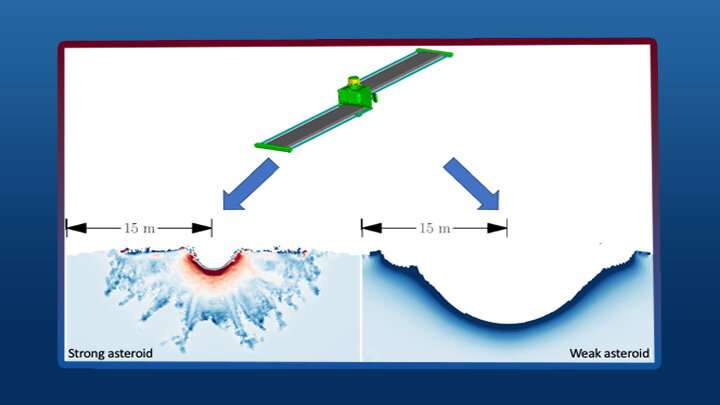Revealing spacecraft geometry effects on impact simulations for NASA's DART mission

NASA's Double Asteroid Redirection Test (DART) spacecraft will crash into asteroid Dimorphos on Sept. 26, executing the first asteroid deflection test that has been years in the planning.
Dimorphos, at 150 meters across, is the "moonlet" of a binary asteroid system, orbiting the larger companion asteroid, Didymos (800 meters). The momentum of the ~600 kg spacecraft, traveling at ~6 km/s, will deliver a small change in velocity to Dimorphos, which will be detectable from Earth-based telescopes as a change in the asteroid system's orbital period.
As part of this mission, Lawrence Livermore National Laboratory (LLNL) researchers have been contributing multiphysics simulation expertise to this planetary-defense tech-demo mission since 2014, developing new methods to simulate the range of possible asteroid targets and to model the DART spacecraft with higher fidelity.
A new paper in The Planetary Science Journal, "Spacecraft Geometry Effects on Kinetic Impactor Missions," led by LLNL's Mike Owen, explores the consequences for including realistic spacecraft geometries in multiphysics simulations.
Previously, most impact modelers considered idealized forms for the DART spacecraft, such as a sphere, cube or disk. Using the detailed, computer-aided design (CAD) models provided by spacecraft engineers was not a readily-available capability for many impact codes. Owen worked to streamline the process in Spheral, an LLNL-based Adaptive Smoothed Particle Hydrodynamics (ASPH) code for which he created and serves as the lead developer. Collaborators across the U.S. and internationally also worked to implement CAD-based DART geometries, providing code comparisons for both the detailed and more simplified spacecraft geometries, as part of the study.
"Over the years many researchers have put a lot of work into studying how kinetic impactors like DART might perform if we had to divert an asteroid, using both numerical models and laboratory experiments," Owen said. "Almost all of that research focuses on the effects of how different properties of the asteroid itself might affect the outcome, but of all the unknowns in these scenarios probably the one factor we know the most about is the spacecraft itself, which is generally approximated using a simple solid geometry like a solid cube or sphere."
Owen said now that a live full-scale experiment in the DART mission is being conducted, it makes sense to look at how important the actual spacecraft geometry that was launched might be, particularly given how different the spacecraft looks compared with typical simplifications.
"These realistic models are very challenging to set up and run, and we had to develop new capabilities in our modeling tools to be able to tackle this problem," he added.
The geometry of the DART spacecraft, which consists of a vending machine-sized central body (1.8 x 1.9 x 2.3 m) and two 8.5-m solar panels, creates a much larger "footprint" than a solid sphere of aluminum at the same mass. This affects the cratering process, and ultimately, the momentum imparted to the asteroid, lowering it by ~25%. While this is a measurable effect, uncertainties in asteroid target properties can produce even larger changes in deflection effectiveness.
However, modeling the full CAD geometry typically requires finer resolution, and can be computationally expensive. Owen also explored cylinders of different thicknesses and three-sphere approaches to the problem, to find a "middle ground" that was easier to simulate but also behaved more like the real DART spacecraft. A three-sphere model was able to account for most of the effect of using full spacecraft geometry. This three-sphere simplification enables many more models of the DART impact, across different codes and users, to be run accurately.
"While it may seem intuitive that an idealized spherical representation of DART would over-estimate the deflection, quantifying this effect was important for understanding the limitations of prior approaches," said Megan Bruck Syal, LLNL's planetary defense project lead. "Carrying out this study was an essential component of preparedness for the DART experiment, and has redefined best practices for both LLNL and other impact modeling groups."
More information: J. Michael Owen et al, Spacecraft Geometry Effects on Kinetic Impactor Missions, The Planetary Science Journal (2022). DOI: 10.3847/PSJ/ac8932
Journal information: The Planetary Science Journal
Provided by Lawrence Livermore National Laboratory





















